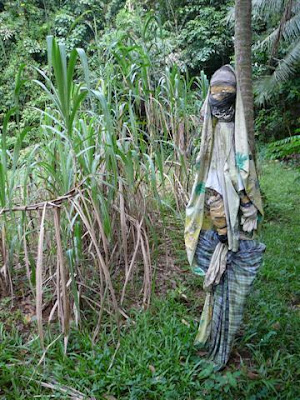The last part of our weekend Ubin exploration was the sensory trail. Walking past the journey towards the trail, there stood a rather rare fig tree near the Ubin information kiosk. Their flowers are interesting because they are not exposed but found within the fig itself.
Ron shares with us this remnant of history that has been sort of reclaimed back by another fig tree. It is related to dynamic storing and breakmaking. To know more how they come to be involved with this shed, browse Ron's Tidechaser blog post here.
Opened 2000 by the American Ambassador, this sensory trail allows even the handicapped to enjoy nature.
How does the blind get to enjoy nature then? By their sense of smell. That is why this is called the sensory trail. You get to use different senses to experience the flora and fauna. The sweet smelling pandan gave the area a sweet aroma.
What kind of fruits does this tree produce that can attract all sorts of birds and even humans?
This mulberry fruit! When riped it is sweet and is redish to purplish in colour.
huh? are there henna art services available in the sensory trail?
No of course, but the leaves above can produce red dyes that are used for henna art painting. Interesting isn't it ?
These aloe plants are no strangers to any of us right? We use their product in many different ways like for food, cosmetics etc.
What amazes me again of these wonderful plants is this citronella plant. Break the leaves apart and smell it. Suddenly you felt that you have applied insect repellent. Yes. citronella is one of the ingredients of the insect repellent we use. Now you know what to plant in your backyard to get free supplies of insect repellent. Isn't God's creation wonderful, especially when we know how to harness their uses?
Next we encountered the garlic vine...
What attracted us are these beautiful blooming garlic flowers :-)
Suddenly, everyone's heads turned up as we see hornbills fly past high. Glad I managed to get a snapshot of one hornbill resting on the leaf blades.
Back to trail, we saw many other different familiar plants like these laksa leaves.
The yellow flowers of this interesting toothache plant can be chewed by people to soothe toothaches. I wonder how does people get to know their functions from the start? Do they go around chewing all sorts of flowers and plant parts? Hahaha.

I always remember this blue pea vine or Clitoria that my secondary school biology taught us. Their blue coloration can be used to make kwehs.


































No comments:
Post a Comment